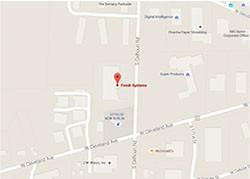Free Shipping on Orders Over $299 (Restrictions Apply)
PROPER GUN DISTANCE
When I was first given a spray gun they handed me a JGA-502 gun then turned away and closed the booth doors. Years later someone told me the distance between the gun and the substrate should be the distance between my extended pinky and thumb, which is 8-7/16”. Thanks to an application tip from the people at SATA, I have learned a better way to establish the proper gun distance. To establish this distance without spraying yourself try this technique. A properly adjusted gun needle will allow you to just pull the trigger emitting only atomizing air without any coating. Now move the palm...
“Mesh -vs- Micron Filtration…What is it All About?”
When discussing air or fluid filtration we sometimes sense that some people have the impression that a 50 mesh screen and a 50 micron filter bag provide the same degree of filtration. In reality, a 50 mesh screen is five times more course than the 50 micron filter. The mesh (sieve) system is based on the number of meshes per linear inch. Whereas, a micron rating filter is based on the maximum particle size that will pass through the filter media. Coating Manufacturers prefer the micron rating system. They use an absolute rated micron filter bag for their final filtration when they package their...
How do I properly clean my spray equipment after using waterbase coatings?
Fairly often when discussing water base coatings the customer will ask “why are water base coatings so tenacious and sticking to my guns?” We feel the quick drying water-reducible acrylic resins and the lack of a solvent in the water base coating to re-wet the acrylic resin is behind the build-up on your spray equipment. Our recommendation to deal with this issue is to use stainless steel wet parts in your equipment, which you should already be using, and promptly flushing your equipment with a water solution containing 10% ammonia. We suggest you purchase the standard ammonia without the scented...
“The 3 Ounce Rule”
As you may be aware, there is a new 3 ounce rule from the EPA Office of Air Quality. Rule: Spray-applied coating operations containing HAPS, HEAVY METALS, or PAINT STRIPPER using a hand-held device that creates an atomized mist of coating and deposits the coating on a substrate outside an operating spray booth, mix room, or prep-station cannot have a cup size greater than 3 ounces. This rule applies to: Auto-body refinishing operations that encompass a motor vehicle, and mobile equipment spray-applied surface coating operations. Or any spraying of heavy metals or paint stripper containing; methylene-chloride, chromium, lead, manganese, nickel, or cadmium....
Breaking the Code – MSDS
Material Safety Data Sheets (MSDS) are documents which include information on the products you use in your workplace and/or at home. MSD sheets involve products we inhale or come in contact with that pose potential health concerns, such as: paints, glues, chemicals, solvents, and air borne dust resulting from sanding surfaces and working with polishing compounds. There are a minimum of nine sections within the MSD sheets. Section 1 provides the products’: name, product identification, manufacturer’s information, and emergency phone number. A duplication of the products Hazard Material Identification Systems (HMIS) appears in Section 1, which is also present on the commercial...
